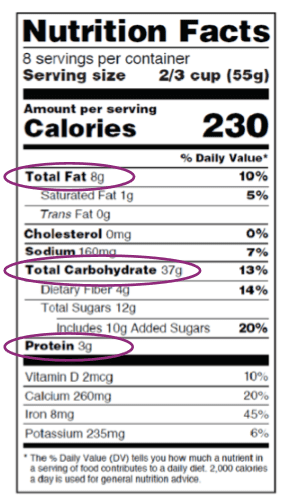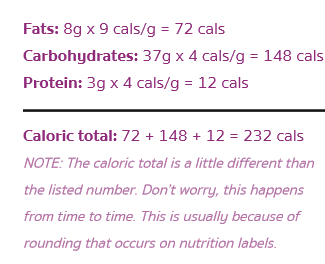Macros Summary
Two years ago if you had asked me what “macros” were I would have stared at you with a blank face and my mind would have started to drift to thinking about macaroni and cheese. In the last several year “macros” have become quite the buzz word and it may feel like everyone is talking about counting them right now. The reason is simple – it works. By setting and tracking your macros you get the right nutrition in the right ratios to support your performance, physique, and health goals. It provides structure yet with enough latitude to build a menu that works for YOU.
Wait a minute, let's back up.
What are “Macros”?
With the risk of sounding too “science-y” here's the definition: a macronutrient is any of the nutritional components of the human diet that are required in relatively large amounts: protein, carbohydrates, and fats.
Macros are what make up the calories of your food. 
When we say “counting your macros,” we’re talking about tracking your calories, but specifically breaking those calories down into your intake of carbs, fat, and protein.
Why count macros?
Losing weight really comes down to eating fewer calories than you expend. Cutting calories by any method is going to result in weight loss; however, the quality and permanence of that weight loss is vastly different. Instead of just counting general calories, knowing how much of each macronutrient to include in your diet yields better results.
For example, if your typical diet and exercise puts you in a caloric deficit (eating fewer calories than you use each day) but you aren’t eating enough protein, your body will break down muscle for use as energy. If you aren’t getting enough carbohydrates, you’ll likely feel weak and unable to perform well during workouts. Carbs are fuel! Lastly, not getting enough fat in your diet can mess with your hormones, which can make your weight loss stall or even make it more difficult for you to build muscle, since eating healthy fats can naturally boost your levels of growth hormones.
Yes, you can lose weight by cutting calories, but we aren’t just interested in dropping weight. We want to lose fat, and we want a good-looking, athletic, healthy body. For that, counting calories isn’t enough—you need to count your macros.
Each macronutrient contributes calories to your food. Here's how much:
How do I find out the macros of the food I eat?
Most foods you eat have a nutrition label that looks like this:
On the nutrition label, you will always see the three macronutrients listed with the number of grams the product contains.
In this nutrition label, you can see the following:
• 8g of fat
• 37g of carbs
• 3g of protein
Based on the caloric value for a gram of each of the macro nutrients listed above (1 gram carb = 4 calories, 1 gram protein = 4 calories, 1 gram fat = 9 calories), you can see how this product’s 230 calories are broken into the three macros:
If what you are eating doesn’t have a nutrition label (think: an apple), then you can use a database (like MyFitnessPal) to calculate the macronutrients.
Why can't I just cut out carbs or sugar to lose weight?
Cutting calories in any form is going to help you lose weight. But if you tell me that you aren’t going to eat any carbs or sugar ever again (or any other extreme restriction used to lose weight), then I’d say you have more willpower than 99% of the population. Chances are you will “mess up” by eating something off-plan and then feel guilty. With counting macros (you will also hear it called IIFYM – If It Fits Your Macros – or flexible dieting), there aren’t “good” and “bad” foods; it’s all just food. Flexible dieting is built on the basic knowledge of certain macronutrients and gives you a precise amount of each macronutrient to include in your diet. If you want ice cream for dessert, have it! You just have to make sure not to go over your daily allotment of carbs or fat. If you fit it into your macros, it’s not a cheat, it’s not bad—it fits! And if it fits your macros, you can eat it guilt-free and without feeling like you “cheated” on your diet. This is a sustainable way of eating.
Don’t get me wrong; it would be really hard to eat processed foods and treats all day long but still hit your macros. Most of the food you consume needs to be nutrient-dense food like lean meats, whole grains, fruits, and vegetables. But the beauty of flexible dieting is that you can easily make room for treats and still reach your weight-loss goal. It’s a moderate, healthy way to approach food.
How do I get started?
-
-
- Buy a food scale: Get used to weighing out your food instead of using measuring cups and spoons. Why is this important? Because it’s so much more accurate! It’s too easy to overfill measuring spoons and cups, which leads to eating extra calories and stalled progress. It will take time for weighing and tracking to become a habit. For the first couple of weeks, it may feel like it takes forever to weigh and log everything, but I promise it will get easier and faster. After about two to three weeks of tracking, it should only take you about five extra minutes a day.
- Download a food-tracking app: Personally, I love using the app MyFitnessPal (MFP). It’s user-friendly, tracks everything for you, and the database is huge and fairly accurate. Play around with MFP. It takes some getting used to, but the tracking capabilities of MFP make it well worth the time. And it does get easier. Figure out how to find foods, how to adjust the serving size, and how to add recipes—those are the tools you will use the most.
- Log your normal intake for 1 week: You aren’t trying to hit any macros or calories, just eat normally and track your food choices. This will both give you practice using your tracking app as well as give you a clear picture of your normal diet. You will be able to see your current caloric intake and macros and have a MUCH better idea of how to accurately set your numbers moving forward.
- Set your macro goals: You can set your macros either through a coach (like me!) or on your own. If you want to set your own macros I have created a free cheat sheet to help you do it as accurately as possible. You can download that here:
-








How do I get my macros numbers? I’m 43, had 6 babies so I have a belly, I weigh 145 pounds, am 5ft7in, and work full time. Where do I get started?
You can start by downloading the free guide to setting your macros at the end of the post. If you want me to set your macros or coach you check out the “Work With Me” tab at the top of the page.
Download the free guide to setting your macros! It will walk you step-by-step through the process.
Seeing the muscle definition is a matter of 1) building the muscle and 2) getting lean enough to see it. If you are focusing on getting leaner that is caused mostly by your diet which is why counting macros can be effective for your goals.
I calculated my macros using your cheat sheet (which i LOVE) but my carbs are really super high and i have found that my body does well when not eating that many carbs. What do you think?
Thank you!!!
Hey Kelsey!
If you know your body doesn’t do well with carbs then just set your fats in the higher range that I give and that will bring your carbs down.
Good Morning! What do you charge to “set” the macro numbers? And exactly what do you need to do this?
Thanks!!
It’s $50 and you can find that option at https://www.bicepsafterbabies.comproduct/custom-macros/
Hi Amber, thank you for your willingness to share all your hard earned knowledge with us! First of all I am not new to IIFYM eating and counting macros, but this is my first foray into calculating my own. I had a wonderful coach before, but perhaps due to my age (53) I gained weight and not in a muscular way. So I am not going to her any longer. I have taken off some of the weight I gained under her tutolage but am still about 30 pounds heavy. I do Crossfit and I am running about 20 miles per week, and the pounds stubbornly remain. So I am anxious for your knowledge to help me really dial it in. So I downloaded your How to Calculate Your Macros, and I think I am not doing the Carbs piece right. So any tips about would help. I keep getting 447 grams of carbs and that just doesn’t seem right. My TDEE = 1965 for maintenance; I currently weigh 156.6 pounds; I came up with 141 grams of protein; and 70 grams of fats; with just 21 grams of fiber. I also think the fiber should be higher. Thank you for your time.
My guess is that you got 447 calories of carbs, which you would need to divide by 4 to get the grams. 447/4 = 112 g carbs.
Hello!! I would really like you to calculate my macros for me. When I went to the web sight you had put down on the previous page it said that the web site does not exist. Where should I go?
Sorry about that! Here’s the current direct link: https://biceps-after-babies.mykajabi.com/offers/m7FBEwLL/checkout